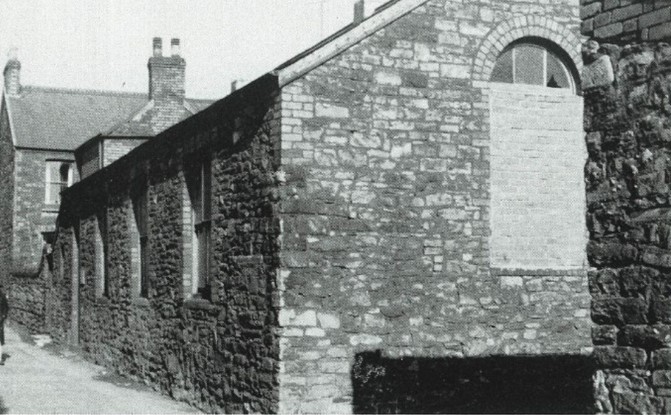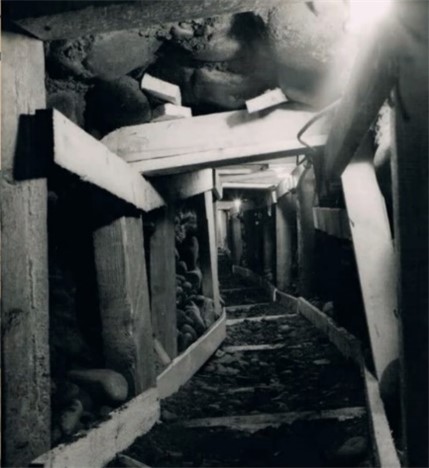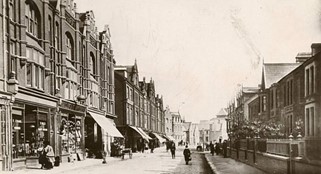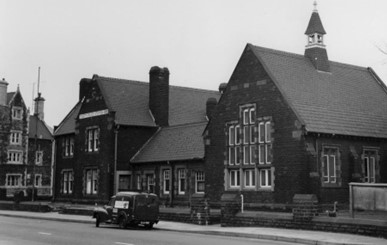Port Talbot Town Heritage Trail
- Port Talbot Town Heritage Trail
- Vantage Point 1: Carmel Chapel, Riverside
- Vantage Point 2: Bethany Square
- Vantage Point 3: Glanafan School, Station Road
- Vantage Point 4: The Grand Hotel
- Vantage Point 5: The Plaza Cinema (Grade II Listed)
- Vantage Point 6: The Station Square
- Vantage Point 7: Aberafan Bridge (Grade II listed)
- Vantage Point 8: The Civic Square
- Vantage Point 9: Aberafan Shopping Centre
- Vantage Point 10: St.Mary’s Churchyard
- Credits
Vantage Point 3:
Glanafan School, Station Road
Continuing down the Station Road, on the left-hand side you will see the old Glanafan School, set a little back from the pavement and up a ramp, now converted into housing and with a glass-fronted porch.

Glanafan School, previously known as the County School
Port Talbot had two grammar schools: Dyffryn, usually known as the Sec., in Taibach, famous for its connection with Richard Burton and his mentor Philip Burton, and Glan Afan in the centre of town.
Glan Afan was built in 1893 on land donated by Emily Charlotte Talbot. She also donated £500 and was invited to lay the corner stone of the new school, which began as the County school. The School opened in September 1896 and continued to flourish until 2016, when staff and pupils were moved to Ysgol Bae Baglan, combining Glan Afan, Cwrt Sart and Sandfields Comprehensive Schools, as well as Traethmelyn Primary School.
Like Dyffryn, Glan Afan school produced a number of distinguished pupils. The best-known currently is Michael Sheen; but a small selection of others includes David Carpanini (artist); Wil Ifan (Poet; Archdruid); Clive Jenkins (union leader); Gwyn Williams, (author); and Ronald Welch, né Felton (winner in 1954 of the Carnegie Medal for the best children’s Book of the Year).

Michael Sheen

Wil Ifan

Clive Jenkins
To read more about the work of the artist David Carpanini: https://fossegallery.com/artists/david-carpanini/
Over the years the site had become congested with new classrooms etc, and when the school moved out, the site was used for housing. Happily, the facade was retained, and Glan Afan still offers a green oasis in the middle of the town, with a public space in front, currently a café.
Moving on we come to Tydraw Place, to the left. Not easily seen, but along this street is the site of the old Synagogue.

The Port Talbot synagogue
If you wish to walk up this road, in the back lane, to the right, is a building which was once the town’s synagogue, home to a small but thriving Jewish community. Among its members were the Arron family, and Ben Arron the comedian keeps up his links with the town. However, some forty years ago the congregation became too small to sustain a synagogue and the members had to join the Swansea congregation. The building is now the Spiritualist Church.
For more information about the Jewish community in Port Talbot: Link to Jewish History Association of South Wales: https://www.jhasw.com/
This organisation has an illustrated account of the Jewish community in Port Talbot with oral history interviews, at: https://www.youtube.com/watch?v=xUz6uLORp-c
Return to Station Road and continue along it to Courtland Place.
The building on the corner here was, until 2023, first the Midland Bank, then HSBC.

The former Midland Bank
This bank earned notoriety as the scene of an intended bank robbery. One of the shops opposite (later Selwyn Jenkins sports outfitters, but at the time empty), was rented by a gang who tunnelled under and across the road, hoping to break into the Midland Bank on a Bank Holiday weekend. However, ‘Mr. Big’, the ringleader, failed to pay the rent for the shop. When the shop owner went to ask about this, he found the shop empty, but the start of a tunnel in the middle of the floor. He notified the police, who then kept a watch on the diggers, hoping to catch them all in the act. However, after a while it was clear that they were about to break into a major drain and drown themselves, so the police arrested them. ‘Mr Big’ was never caught. In June 2023 this bank branch closed.

The bank robbers’ tunnel
The Courtland Place junction marks the point at which the buildings in Station Road, particularly on the ‘mountain’ side, change. Earlier, opposite Glan Afan, they were originally cottages with front gardens (hence the wide pavements), which gradually became shops with the shopkeepers living upstairs.
Back in Station Road, the buildings after Courtland Place date from the 1890s, when the town area near the Docks was developed. They are ‘commercial’ architecture, designed for shops, with offices above, rather than for living quarters. (Look above the ground floor to see the unified designs of the buildings.) As late as the early 1970s these still reflected the maritime history of the town, with a ship`s chandler, shipping agents and similar offices.

Station Road 1908
Continuing along the street on the left you come to what was once Lloyd`s Bank, perhaps the town’s best example of early 20th century bank architecture.
A number of the banks and major retailers in the town were duplicated, with an original branch in Aberafan and a branch in the new area across the bridge, and these were often consolidated into one in the 1970s. (Another example is Woolworths.) Initially Lloyd’s became a public house, ‘The Bank’, before Pizza Hut. It now also has a Lextan salon.

Lloyds Bank
Next cross Grove Place to your left, and come to what was once the town’s main police station.
THE OLD POLICE STATION
This was an interesting building, built in 1898, as part of the development of the area near the docks, replacing the original Police Station in Aberafan town centre. This building was knocked down in its turn in the 1970s and replaced with a nondescript block, which was itself knocked down some fifty years later, and replaced with a residential and retail block, now known as Tŷ’r Orsaf (Station House).

Port Talbot Police Station, Station Road
Follow Station Road down on the left and you will find the next QR code 4 on the Grand Hotel on the left.
